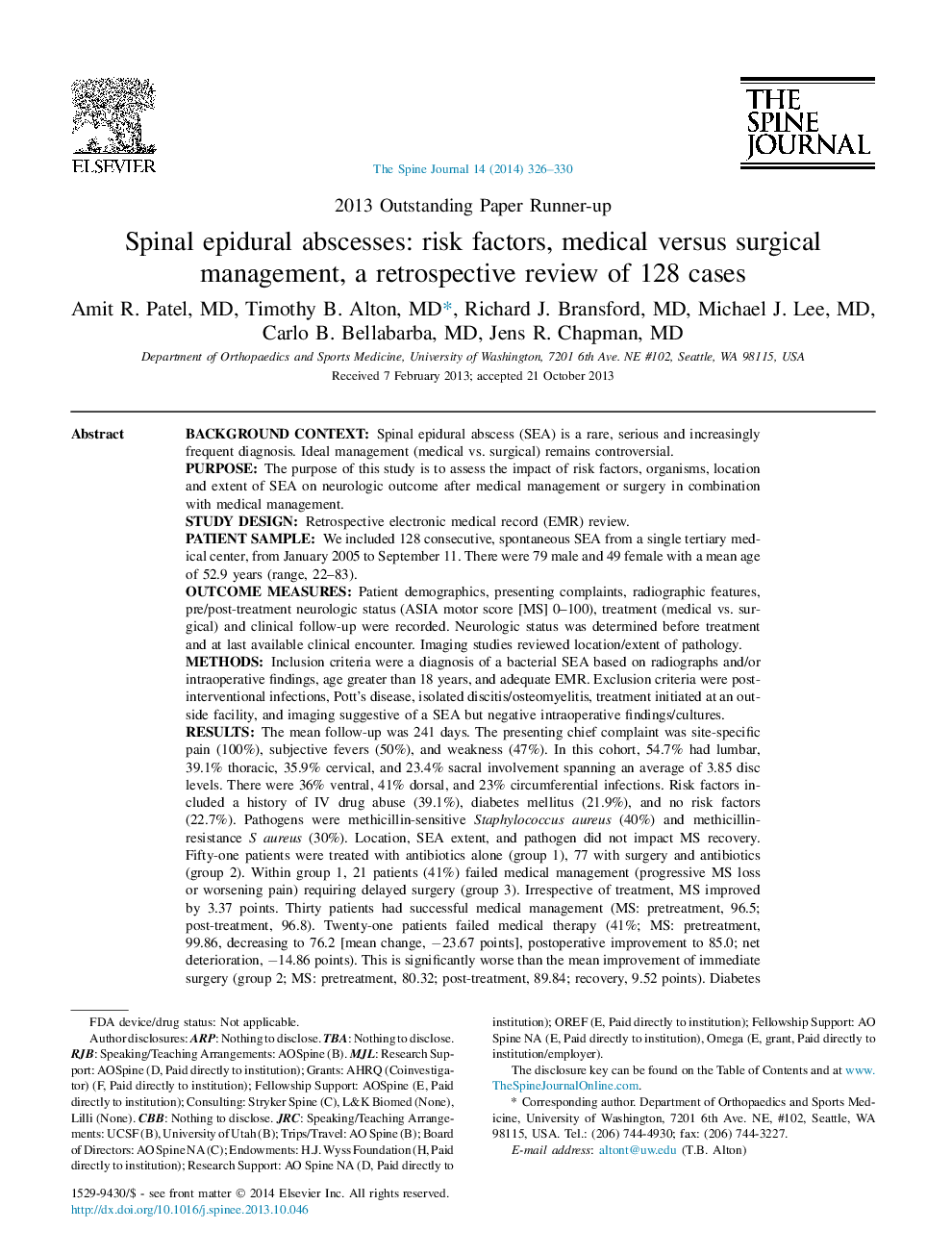| کد مقاله | کد نشریه | سال انتشار | مقاله انگلیسی | نسخه تمام متن |
|---|---|---|---|---|
| 6212893 | 1268605 | 2014 | 5 صفحه PDF | دانلود رایگان |
Background contextSpinal epidural abscess (SEA) is a rare, serious and increasingly frequent diagnosis. Ideal management (medical vs. surgical) remains controversial.PurposeThe purpose of this study is to assess the impact of risk factors, organisms, location and extent of SEA on neurologic outcome after medical management or surgery in combination with medical management.Study designRetrospective electronic medical record (EMR) review.Patient sampleWe included 128 consecutive, spontaneous SEA from a single tertiary medical center, from January 2005 to September 11. There were 79 male and 49 female with a mean age of 52.9 years (range, 22-83).Outcome measuresPatient demographics, presenting complaints, radiographic features, pre/post-treatment neurologic status (ASIA motor score [MS] 0-100), treatment (medical vs. surgical) and clinical follow-up were recorded. Neurologic status was determined before treatment and at last available clinical encounter. Imaging studies reviewed location/extent of pathology.MethodsInclusion criteria were a diagnosis of a bacterial SEA based on radiographs and/or intraoperative findings, age greater than 18 years, and adequate EMR. Exclusion criteria were postinterventional infections, Pott's disease, isolated discitis/osteomyelitis, treatment initiated at an outside facility, and imaging suggestive of a SEA but negative intraoperative findings/cultures.ResultsThe mean follow-up was 241 days. The presenting chief complaint was site-specific pain (100%), subjective fevers (50%), and weakness (47%). In this cohort, 54.7% had lumbar, 39.1% thoracic, 35.9% cervical, and 23.4% sacral involvement spanning an average of 3.85 disc levels. There were 36% ventral, 41% dorsal, and 23% circumferential infections. Risk factors included a history of IV drug abuse (39.1%), diabetes mellitus (21.9%), and no risk factors (22.7%). Pathogens were methicillin-sensitive Staphylococcus aureus (40%) and methicillin-resistance S aureus (30%). Location, SEA extent, and pathogen did not impact MS recovery. Fifty-one patients were treated with antibiotics alone (group 1), 77 with surgery and antibiotics (group 2). Within group 1, 21 patients (41%) failed medical management (progressive MS loss or worsening pain) requiring delayed surgery (group 3). Irrespective of treatment, MS improved by 3.37 points. Thirty patients had successful medical management (MS: pretreatment, 96.5; post-treatment, 96.8). Twenty-one patients failed medical therapy (41%; MS: pretreatment, 99.86, decreasing to 76.2 [mean change, â23.67 points], postoperative improvement to 85.0; net deterioration, â14.86 points). This is significantly worse than the mean improvement of immediate surgery (group 2; MS: pretreatment, 80.32; post-treatment, 89.84; recovery, 9.52 points). Diabetes mellitus, C-reactive protein greater than 115, white blood count greater than 12.5, and positive blood cultures predict medical failure: None of four parameters, 8.3% failure; one parameter, 35.4% failure; two parameters, 40.2% failure; and three or more parameters, 76.9% failure.ConclusionEarly surgery improves neurologic outcomes compared with surgical treatment delayed by a trial of medical management. More than 41% of patients treated medically failed management and required surgical decompression. Diabetes, C-reactive protein greater than 115, white blood count greater than 12.5, and bacteremia predict failure of medical management. If a SEA is to be treated medically, great caution and vigilance must be maintained. Otherwise, early surgical decompression, irrigation, and debridement should be the mainstay of treatment.
Journal: The Spine Journal - Volume 14, Issue 2, 1 February 2014, Pages 326-330
